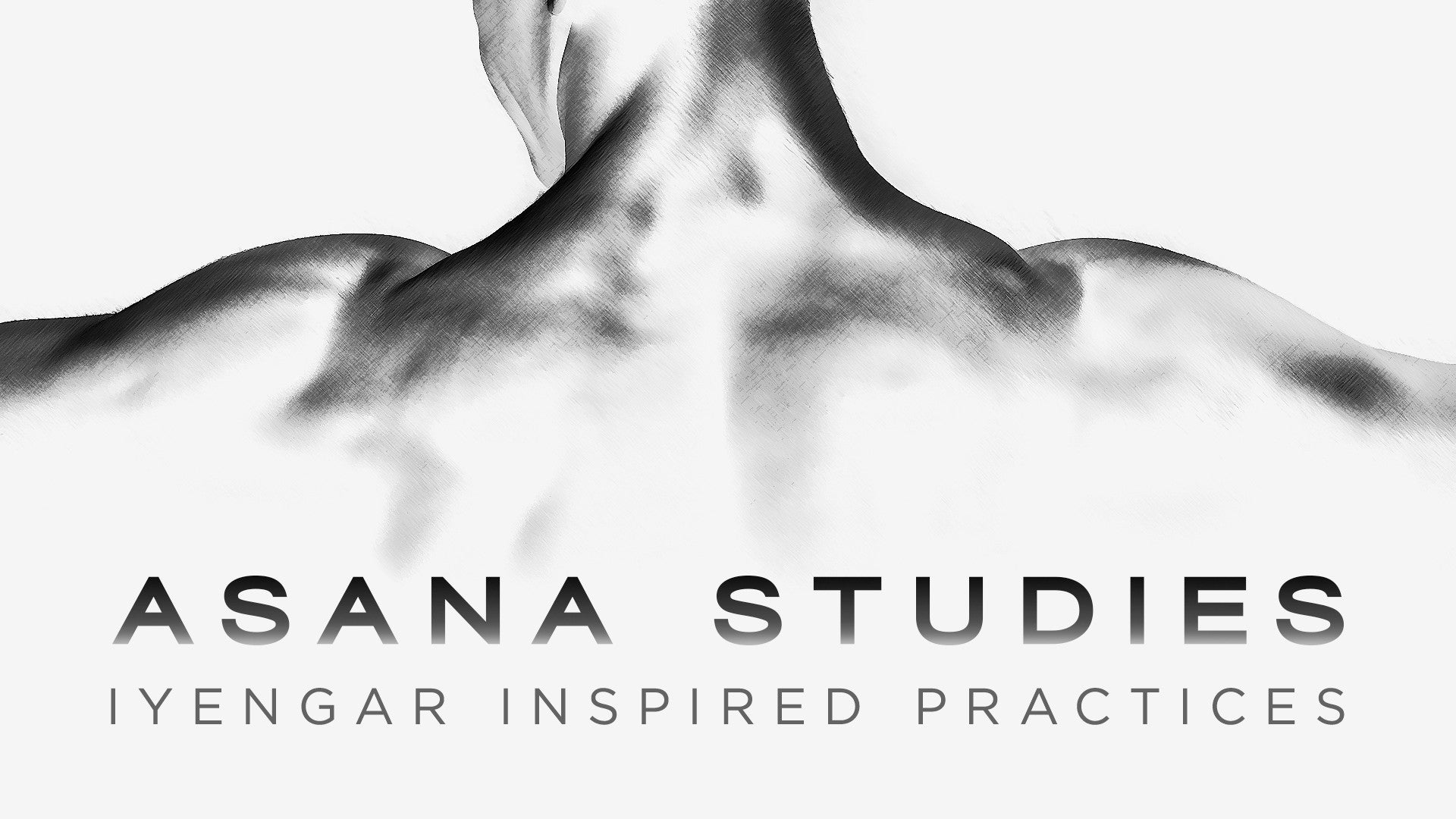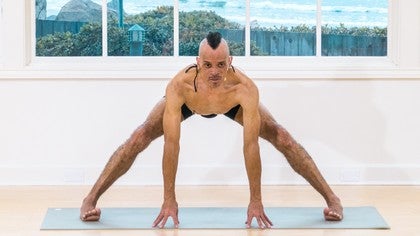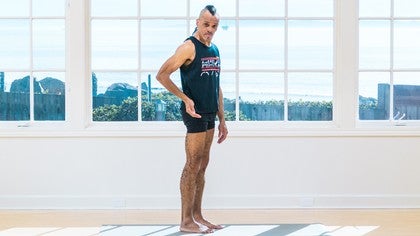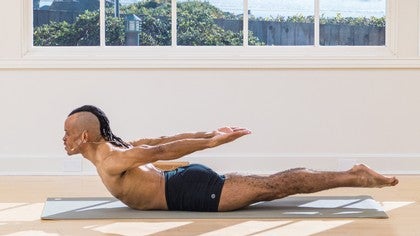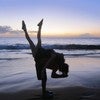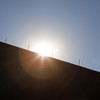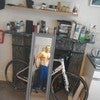Description
About This Video
Transcript
Read Full Transcript
(waves crashing) Okay, so now we're going to take some of the ideas of the foot and leg shaping, the act of Tedasana ideas and put them in the context of a couple simple poses. So we're going to do some standing work, but first I want to introduce you to an exercise that I do called Deep Kneeling Lunge. It's a sequence of movements to cultivate opening in the front of the hips here, in the area of the hip flex. Because when we do the standing work and we need for there to be fluidity in the hips, we want this area to have a sense of openness, so that there can be a sense of movement that can occur here. Okay.
So we'll come to hands and knees. We're gonna start with our hands about as wide apart as our shoulders and the knees about as wide apart as where the thigh bones come out of the hips which is not quite as wide as the hips. And we sit down like so. Now when I teach, I speak in the spacial reference of the student, so when I'm speaking to you, talking about me practicing, I'm gonna speak in my spacial reference, and if you're doing this, this will be in your spacial reference. Now this takes a little getting used to because it's not often that teachers teach this way.
So what I mean by that is, this is my front. If I'm sitting like this, there's my front. Back is always behind me, wherever that is in my spacial area, my kinesphere. Up is always up, and down is always down. Right and left is always there.
So I'm gonna sit down a little bit. I'm gonna start with my right leg going forward first. When I sit down I wanna have a sense that there's some weight in the shins. I call whatever is on the floor the foot, so these are my hand feet, those are my shin feet. So I'm gonna sit down and put a good amount of weight into the shin foot.
And then I'm gonna take my thumb, in the hip crease in my right hip. I'm gonna use this hand to keep my weight down so that when I step up only my leg steps up not the whole body. So I use this hand, I scruff. We talked about scruffing in the Deep Kneeling Lunge, the act of Tadasana. So scruffing again is when the skin sticks on the mat and the bones within the skin sticking on the mat move within a given direction while they move, only as much as the skin sticking on the mat allows them to move.
So that movement is constant. So I'm gonna scruff the bones in the hand with the stickiness of my hand on the floor up towards the mat to shift my weight down. I'm gonna keep that active scruffing, with sustained weight to keep my weight down. I'm going to exhale and step the right leg up. Now when I step the right leg up, I'm gonna put it where, I'm having experience, and you'll learn this with experience where I know the foot needs to be so that when I'm in Deep Kneeling Lunge, my knee will be over my heel.
My weight is still down, and I put my fingertips light on the floor. I remember shaping the feet, ah, shaping the feet. The toes are up very wide, and spread them very wide. Shaping the feet. Now as I come up and in, I try to keep the fingers very light on the floor so that my legs are carrying the weight.
My legs start to understand what they do in this weight shifting action, and as I come in my weight comes forward and up and it sinks forward and down. I drag this heel back towards me and I keep sinking the pelvis, and my knee ends up pretty much above my heel, maybe a little bit in front of my heel, a little bit in front, but basically above my heel. I drag the heel back, so the fingertips are light on the floor. My right hand is in my hip crease. I bring the back torso, as the pelvis sinks forward and down, forward and down toward the space inside my front leg, my right leg heel.
I bring the back up and back. I take my left hand, all five fingers pointing forward to enclose the left side of the pelvis. Now the heel of my left thumb is on the hip point. The little finger side of the heel of my left hand is on the upper outer left gluteus buttocks muscle, and I'm enclosing the left side of the pelvis. So the idea is I'm squaring off the hips, and then from there I put the fingertips on the floor, try to keep them light.
The strong weight that's in my right foot, I put into the floor, I scruff the right foot up to shift the body weight back down. Where it came from, I put the left hand on the floor, exhale, step down with the right hand on the floor. I feel, you wanna feel first before you look that the right knee that was forward. We bring the right knee back, it's in line with where it was, where it started, as wide apart as where the thigh bones come out of the hips. And once I feel that I'll look to see, okay.
Trying to cultivate the ability to feel, to feel before looking. And from here I'll shift the weight down again. Keep the right hand firm on the floor. I'll scruff the right hand up to keep the weight down. I'll put the left thumb in the hip crease.
Exhale. Step the left foot up. Shape the left foot, toes spread wide. Foot very active. I put the right fingertips light on the floor then slowly come forward, and as I come forward as the weight comes in the left heel, I drag the left heel back to me.
I sink the pelvis forward and down. End up with the left knee pretty much over the left heel, and maybe a little bit forward or in front of. The pelvis is sinking forward and down. I bring the back, back and up. Take the right hand, all five fingers pointing forward and enclose the right side of the pelvis.
The idea is to keep the twisting from occurring. To drag this heel back to the floor, the left heel back towards the floor below the left sit bone, to bring the right point forward. The front leg foot is very active. The front leg foot, the left foot is constantly shaping. Breathing easy.
Put the fingertips back on the floor, firm the left foot, scruff the left foot into the floor up towards the head of the mat to shift the body weight down with the right fingertips light on the floor. Put the right hand firm and flat on the floor, exhale, step down. Don't look, feel where it is. Put the hand on the floor, the left hand. Now feel where the left leg is, the leg that was just forward.
Feel that it's in line with where it started out. As wide apart as where the thigh bones come out of the hips, and you can move around a little bit to get there, and then you can look to see, and adjust. We'll do another set of that. So as we work, remember that we talked about standing poses and the elements and the legs having the earth quality, and the pelvis having a fluid quality. Well one of the ways we get at that, we allow it to be, is to allow the groin to be soft.
Now the groin is the very top of the upper-inner right and left thigh muscles, okay. We want to have a sense there that those muscles or that area is relatively relaxed, even if the muscles there are working for whatever reason they may be working, okay. So when I say, I may make reference to softening the groins. When I make reference to softening the groins, that's about trying to let the area, the upper inner thigh muscles relax or that area be relatively passive. Those muscles may be actually working, but allowing them to only work as much as they need to work.
And I'll explain more about why we want that later, besides the fact that we want fluidity in the hips. So we're gonna do another set of that Deep Kneeling Lunge and the idea is to use the shaping of the feet to enhance the earth quality in the legs as a base in which the fluidity of the hips and the legs can coexist in a harmonious way. Use the shaping of the feet to shape the legs and shape the energy in the legs, and ultimately to shape the pelvis. Deep Kneeling Lunge. Hands on the floor, feet about as wide apart as the width of the hips, hands about as wide apart as the width of the shoulders.
Hands are very active. Again, speaking to my spacial reference, I'm gonna scruff the hands up to the head of the mat to shift the weight down, start with the right foot, right leg. So the right thumb is gonna go in the crease of the hip. I'm gonna use the left hand scruffing up to keep my body weight down, exhale. Step only the right leg forward and up.
What you wanna try to avoid on this is doing this. The whole body doesn't step up, okay, it's very important when we do this exercise. Just the leg that's stepping up steps forward and up. Like so, we shape the foot. Light on the fingertips.
The reason we wanna keep the body down when we step the leg up is because we want to experience this weight shift going from down to up, and as we do so using the connection between the right heel, the front leg heel and the front leg sit bone, the bony landmarks to align the bones allows the muscles to follow. So as I come forward and up, as weight comes up into this heel, I drag the heel back to bring this hip point forward and also up so that the hip is square, and when I finish my knee's gonna be maybe a little bit forward in front of where my heel is, but pretty much over the heel. I don't wanna be here, you don't wanna be here. The pelvis is sinking heavily down and forward as I drag the, actively, the right heel back, I raise the upper back, back and up. All five fingers enclosing, this is to help this hip be square, the left hip be square, the back leg hip be square because I want to allow the groin to soften here and allow the fluidity of the hips to be intact while the legs are very active.
And you can see my back foot, I'm actually sort of pointing my back foot. The back leg is very active too, and I'm scruffing, that's the left leg. I'm scruffing actively the right, front leg heel back to. This is about creating this kind of fluidity here, this kind of mobility, forward back mobility. Then I'll put the fingertips light on the floor.
I'll scruff the strong weight in the front leg foot, the right foot up, shift the body weight back down. Put the left hand firm on the floor, scruff it up, keep the body weight down, exhale, step down. Put the right hand on the floor, don't look but feel where the right leg is, and then when you think you can look to see that the right leg is wide apart, inline with the left leg, but both legs are as wide apart as where the thigh bones come out of the hips. Shift the weight down, hip crease. Strong weight in the right hand scruffing up to shift the weight down.
Exhale, I'm gonna look where I'm gonna place the left foot for the second side. Step only the left leg forward now. By this time after a few sets and after some practice, you'll know where to place the foot so when you get in Deep Kneeling Lunge your knee is where we want it to be. Over or maybe a little bit in front of the front leg, in this case the right heel. Fingertips light on the floor, keep the foot shaping.
Come forward and up. As the weight comes into the left heel, I'm gonna begin to scruff or drag the left heel back, the left heel skin sticks and the left heel bones within the left skin sticking drag back. I sink the pelvis forward and down. So I got here, maybe I could have stepped up a little more. If this happens to you, don't adjust it here.
Go back down where you came from, put the hand flat and firm, and then put the foot where it needs to be, once you've found out where it needs to be. Then fingertips, come back up in. As the weight comes in the heel, drag the heel back, the front leg left heel back. Sink the pelvis forward and down, fingertips light of the right hand and then the back comes back and up as the pelvis goes forward and down so we get this effect. All five fingers of the back leg hand, the right hand enclosing, all five fingers pointing forward, and again to help the hips to be square.
So with this heel dragging back, the weight strong down and forward the way the pelvis is strong down and forward down towards the floor. I use a strong weight in this heel, dragging back to the floor below the sit bone to get a sense of the heel sit bone connection here, to bring this hip point forward, legs very active. Try to soften the groin, and then fingertips on the floor. Light, I scruff the strong weight on the front right foot, I shift it up, scruff up to shift the body weight back down. Right hand flat and firm.
Exhale, step down. Put the hands on the floor, both hands. To feel, as a base to feel, and move the feet around, the knees around to feel when they're as wide apart as where the thigh bones come out of the hips. And if you think they're there, look and see. That's a Deep Kneeling Lunge exercise.
Now when you're placing your feet forward, placing your knees, it's okay to move around to feel where you think you are before you look. It's okay to move around to feel where you think you are before you look. Okay. Now we're gonna take some of these ideas and bring it into a couple standing poses. So we'll start with the hands on the hips.
We'll take the same approach we took as we took to active Tadasana and passive Tadasana. You look on the mat where you're going to step. As you step there, shape the feet. Begin doing the active Tadasana. Then when you think you know how the feet are lined up, look and see if they're lined up how you think they are.
Now we're going to do Horse Stance. When you take Horse Stance, you step one foot out and the other foot out, don't look. The floor is down there. If the floor wasn't there, you'd know about it. So just feel.
Now, the reason we did the Deep Kneeling Lunge exercise is 'cause often times when people take Horse Stance, if there's tightness here this will start to happen. So we did the Deep Kneeling Lunge exercise to begin to open this area so we can start to get this shape. This is Horse Stance, notice I'm shaping the feet. In Horse Stance, the pelvis is neutral. It's not tucked under, and it's not the behind or the sit bones reaching back and the pelvis tilting forward.
We wanna have a sense there's a sense of fluidity here. We're using the strength of the legs to articulate again the earth element of the legs, to enhance the earth element of the legs and reveal a strong sense of weight to the bones, specifically to the heels. We make use of the weight to heels to move the top of the thigh bones in the direction we want them to go. In active Tadasana, we move the top of the thigh bones back, here the top of the thigh bones are moving wide. So if you look at this shape, I've been here for a while, after you've been here for a while you can look and see if your feet are lined up the way you think they are.
So we want them pretty much lined up the same way here as they were in active Tadasana. So if you look to see they're lined up, if they're not, adjust them and feel the difference. Now Horse Stance is a pose in which you shape the feet, the weight is going like so. In Tadasana, the feet and legs are right below what they're supporting. In Horse Stance, not so.
The feet are, legs, feet and legs are out, yes. So we then out of necessity, and out of dynamic lift and shaping, and bringing to life this earth element of the legs, and making full use of the earth element of legs and actively involved in the earth element of legs, we take the weight and put it out over where the support is. So as you can see, there is a lift in the inner arch, or the inner ankle rather, and you can see the shape of my ankles, I'm taking the weight out and putting it over where the support is. So also too with the legs wide, the heels won't actually scruff. So the heel skin is sticking, the heel bones are sliding that way, and as the heel bones slide out to the side, the right and left wall, my thigh bones are also moving out.
So I'm using the heels, the scruffing of the heels and scruffing the heels apart to move the thigh bones wide. The thigh bones are now moving two of the three directions principally we want them to move depending on the shape and where the torso is. So now the thigh bones are moving wide. Horse Stance the sense of fluidity in the hips. Now when you do this, you'll feel your leg muscles working, but principally the bones are carrying the weight.
We're shaping the feet so the weight is in the heels. And the bones then are right siding over the heels. It's for the purposes of this activity that we do this. Other activities we'd put the weight someplace else in the heel or in the foot rather. But here it's okay to let the weight to be in the heel.
Use the weight in the heel to shape the feet. Here, also too, the buttocks is relaxed. Notice what happens when I tense my butt, I'm gonna tense my butt. Watch how the quality in this are changes when I squeeze my butt, contract my butt. Now watch when I relax it.
Watch again. Now watch when I relax, watch how the whole weight changes. So that's what I wanna do, I wanna let the hips be fluid so the weight goes through the fluidity of the hips, it's a very important gateway down through the active support of the legs. Tadasana. Again back to Tadasana, shape the feet.
You think you know how they are, you can look and see. And let's just take passive Tadasana with the eyes open for a moment just to rest. Good. Horse Stance again, now let's do some other movements in Horse Stance, step out. Now how wide do you set up in Horse Stance?
Hmm, good question. So maybe your feet can go way way way way way out there. Way out there, is that appropriate? Hmm, how do you know? How you know is that where you put your feet, where your feet are, you want to have your thigh bones to accommodate that width.
So if my feet are out here, the further out they go, even if I'm actually able to shape the inner ankles and feel as if I'm putting from the leg, the knee rather down to the ankle, the weight over the heel, look what's happening here, this is falling in. Okay, so if I go way out, even with some sort of shaping that we're going for in the ankles, my thigh bones aren't going out because they're outside of the reach, the purview of my feet. So I'll bring my feet a little closer to each other, and now I can feel my thigh bones going wide. Okay, we want the thigh bones wide because we want lots of spacing here. And now from here we're gonna do Pitching Forward Fold in the Horse Stance.
So you press the heels, as you press the heels you wanna take care that you don't lean forward, but you press the heels and lift the sit bones. From the heels pressing, the sit bones in Horse Stance are pointing down. I'm gonna press the heels to begin to lift the sit bones and take the sit bones back to the wall behind me, and then as I forward fold, my back is in the same shape. My back is extended. Holding my back, take care here that you're not pressing the elbows back.
The elbows are sort of light at your side so you use the heels and the energy to the legs through the fluidity of the hips to hold your back where it is. And then from there I'll press the heels on the floor, and now the heels are taking the thigh bones wide and down because my front has changed. That's back, that's up, that's down. This is front for me. So my thigh bones are now moving wide and down, but they're not collapsing in, they're moving wide.
So there's lots of space here. I use the heels on the floor then to move the top of the thigh bones down to come up right, as I come up right, this is my front, this is back. Now I'm using the heels to move the thigh bones wide, and now I'm gonna use the heels to straighten the legs like we did in active Tadasana to move the top of the thigh bones back. So now I'm actively moving my thigh bones wide and back, there's lots of space here. Lots of ease here in the groins.
So the legs are strong, feet are shaping, and the butt's soft. And even here you can take your hands like we did in active Tadasana, and feel the hamstring is firm and the buttocks is relaxed. Now with the legs straight, I'll do the same thing that I did with the legs bent in Horse Stance. Watch what happens when I squeeze my butt. Now watch what happens when I relax my butt.
Look what happens in the face. Okay? And then from there, step step to Tadasana. Again shaping the feet, just feeling. (breathing deeply) You notice all this movement that's happening up here?
That's because I wanna have a sense that this is fluidly riding over and is appropriately so, this investigation that is happening down here, that I'm not observing with my eyes, I'm observing with feeling. Okay, and then you can feel how the feet are, you can look to see, adjust them accordingly and then look back up. Let's just take passive Tadasana for just a few moments with the eyes open and just noticing what you notice. Letting the body breathe, allowing the weight to be in the heels, and the bones and the muscles that were so active when we're working, allow them to be ask relaxed as possible. And then we'll shape the feet again.
When you step out to Horse Stance, you can step out with the right foot or left foot, whichever feels okay to you. Step out to Horse Stance. You can alternate. Now in Horse Stance, it's usually heels on the floor to straighten the legs, to move the top of the thigh bones back. Getting up on the legs, and now we're gonna do a weight shift.
On the weight shift, I'm gonna scruff my left heel to the left wall to shift the weight over to the right side. As I scruff my left foot to the left wall, shift the weight to the right side, I keep as much weight in the inner left thigh as possible. And the inner left ankle as possible, and just feel how that feels. So it's an illusion of weight shift. I shifted the weight slightly to the right, but I keep as much weight on the left side as possible and then come back to the center.
We'll do the same thing to the second side. Scruff the right heel to the right wall to shift over to the left side. As I do this, keep as much weight on the right leg as possible and the inner right thigh moving to the right wall. It's an illusion of weight shift over to the left side keeping as much weight on the right side as possible. And then coming back to center.
Let's do that again. Just feel as you shift the weight that you're going towards the right side from the movement of your left heel to the left wall, and lifting the inner left thigh. So not letting it collapse like so but creating lots of lift with the shape of the left foot. And just feeling the weight over there. And come back to center, now scruff the right heel to the right wall, both legs straight.
And again, illusion of weight shift to the right side. From scruffing the right heel to the right wall, shift the weight over to the left side. Keeping this much weight over on the right side as possible. Just feel how that feels. Lots of lift in the inner right leg.
Remember you can consider this a side lunge, so the leg that's on the outer leg is the anchoring leg, so this would be my anchoring leg, my side leg in this case right side leg, the following leg is the anchoring leg. Shift the weight back to center, and then from there. Let's do Pitching Forward Fold with the leg straight. Press the heels, lift the sit bones, Pitching Forward Fold holding the back. Go as deep in the fold as you can before your back rounds.
So keep the back lifted. If you're not sure, you can take your hand on your lower back and feel that your lower back is flat, extended around and extend the spine. And then here stay in the fold, we'll do Horse Stance in the fold. As you bend the knees, feel the thigh bones going wide and the arc of the energy and the legs going out. So we have this active grounding arch shape.
Press the heels and act like you're gonna straighten the legs, lift the sit bones and bring the head back to look up. And then from there come up right in Horse Stance, use the heels on the floor, move the thigh bones to the top of the buttocks, back to the wall behind you. Take your hands and slide your hands and feel that the buttocks is soft and the hamstring is firm, and then from there step step to Tadasana. Now, take the feet as wide apart as the width of the hips. And again shape the feet.
Feel from the shaping of the feet that your feet are as wide apart as the hips and then look to see if they are. So this is about as wide apart as the hips for me. That means the outer edges of your feet are gonna be about as wide as the width of your hips, and then from there take the hands on your hips and again bend the knees, take a forward fold. Let your belly go to thighs and let's just do a little Uttanasana. Let the head hang, letting your body breathe.
Here notice, try to scruff the heels apart. Try to scruff the heels apart. try lifting the outer arches, and from the heels scruffing apart, try spinning knees out as you're hanging. So you can play with doing the foot length shaping here. Letting your spine pour out of your pelvis.
Let's let the arms hang, press the heels. Again act like you're gonna straighten the legs, and bring the head back to look up, and just stand all the way up. And from here let's take the hands on the hips. Let's step out to Horse Stance again. We'll do one more illusionary weight shift.
Here we'll do it from the Horse Stance from bent legs. Before we did it from a straight leg to one leg bent, now we'll do it from both knees flexed or bent, and now that you're here if you wanna check at any point to see that your feet are lined up the way you think they are you can always check. And then from there let's take the arms up for this set. You're gonna move to the right side, it's an illusionary weight shift, so as you move to the right, you scruff the left heel to the left wall and keep the weight as centered as possible and there's a very slight movement to the right side. Take your left hand and feel that the buttocks is soft and the hamstring is firm.
You can even look down at the foot to see that the shaping is as such, the inner ankle's lifted and not collapsed. And the from there scruff the right heel to the right wall, come back to center. Let's do the second side. Scuff your left heel to the left wall, using the left heel on the floor to move the left thigh bones below the buttocks back to the wall behind you. Stay as centered as you can.
Take your left hand and feel that the left buttocks, or the right hand rather, the right buttocks is relaxed and hamstring firm. And then come back to center, shift the weight back. Hands on the hips. Let's take it once again. Bring the hands to Namaste and take Horse Stance with the hands in Namaste or Anjali Mudra.
Arms up. Let's do the illusionary weight shift with the legs bent. So shifting from scruffing the left heel to the left wall, shift the weight over to the right side. Take your hand and feel that the buttocks is soft, the hamstring is firm. Feel the quality of lift so that your anchor leg is actually moving, and as much weight on that side as possible.
Come back to center. Use your right heel, scruff it to the right wall to move the right thigh bones below the buttocks back to the wall behind you. Take your right hand to feel that the hamstring is firm, the buttocks is soft. Come back to center. Hands on the hips.
And use the heels on the floor to move the top of the thigh bones with the buttocks back to the wall behind you, and do another Pitching Forward Fold. Now when we do a Pitching Forward Fold, when you do a Pitching Forward Fold take energy from below the buttocks down the back of the legs through the heels and the pelvis folds at the hips, your back stays in the same shape, go as deep into your fold as you can with your leg straight this time. As deep as the fold as you can before your back rounds. And then from there use the heels on the floor to move the top of the thigh bones down. They're moving wide and down now, but keep moving them down to come upright.
As you're upright now the thigh bones are moving back. Step step to Tadasana. Shape the feet. Feeling, see what you have, adjust it if you need to. Passive Tadasana.
Let's close the eyes and rest for a few moments. Notice what you notice, again allowing the bones to carry the weight as much as possible. Now we use passive Tadasana as a pose of reflection. Allow the leg muscles to be as relaxed as they possibly can, you can touch your leg muscles to feel that they're as relaxed as possible with the legs straight. Letting the body take the breath that it needs, bones carry the weight.
Open the eyes, begin shaping the feet. Wake the legs up, active Tadasana for leg shaping. Hands on the hips, step the legs out to Horse Stance. Just feeling. Notice if you can feel the sense of ease in the pelvis, as much as your feet and legs might be working there's a sense of ease in the pelvis and make sure the buttocks is relaxing.
Let's test that again, squeeze your buttocks and feel what happens. Now keep the feet and legs strong and relax the buttocks and notice what happens with the quality of weight and how it flows freely through the pelvis. Again, squeeze the buttocks, keep the feet strong while the buttocks is contracted. Now relax the buttocks, there's a sense of ease and fluidity in the hips as you relax the buttocks. And feel when you relax the buttocks how the way it pours through the pelvis into the legs.
And then from there let's use the heels on the floor to move the thigh bones back. Now the thigh bones moving back and wide, take the arms up. Let's take it into Warrior II pose, let's take the left heel, your left heel just a little bit to the left wall. Bring your right heel in just a little bit. Again, continue to shape the feet as you work, and then from there the strength of the left leg, rotate the right leg out, place the right foot.
Feel the expansiveness across the face of the groins and the feet and legs work, the strength of the legs, and again the pelvis as fluid as possible. And go with the right arm and take your lunge. As you take your lunge, keep as much weight on the back leg as possible. This is leaning, stay as upright as possible when you come to lunge, we're not gonna do a very deep lunge, just a light lunge. And again feel the feet shaping.
Use the shaping of the feet to keep the legs alive and aligned. Then come upright. Strengthen the back leg and then rotate from that lead leg, the right leg forward. Set hands on the hips, Horse Stance. Feel what you have.
So you took the feet out of alignment, now feel how your feet are lined up from the shaping of the feet, and when you think you know how they are look and see if they're lined up the way you think they are. Bring the head back upright. Then use the heels on the floor to move the top of the thigh bones with the buttocks back to the wall behind you. Let's do a Pitching Forward Fold once again. Press the heels with the sit bones, forward folding, feel the fluidity of your hips and the strength of your back, the strength of your legs.
Go as deep in the fold as you can before your back rounds, and then use the heels on the floor and feel now that the heels are scruffing apart, the thigh bones are widening and moving down and use the heels on the floor to move the thigh bones, continue to move them down towards the wall below you to come upright, and as you come upright and feel the thigh bones still moving now back to the wall behind you, and wide. The second side, arms up. Take your right heel just a little bit to the right wall, bring the left heel in a little bit. Again, keeping the feet and legs very alive from the shape of the feet. Rotate the left leg out, go for the left arm.
And as you take the lunge, keep as much weight on the back leg as possible. This is leaning but ride on the legs right on the pelvis, shaping the feet. Again, using the shape of the feet to really keep the legs alive and aligned. Take care that your front knee doesn't fall in, but it stays open. So if you were to look down, you'd see that your knee is pretty much over your heel.
Even if you're not in such a deep lunge that your knee is directly over your heel, your knee is aligned with your heel. A few breaths, breathing easy, shaping the feet. Get a sense of softness in the groins here, an ease in the belly. And then come back upright. Anchor the back leg to rotate the lead leg, anchor your right leg to rotate your left leg in.
Hands on the hips. This is Pitching Forward Fold. Again press the heels, as you press the heels feel the thigh bones wide. As you forward fold feel the thigh bones going back and then down, go deep into the forward fold. This time let's bend the knees and Horse Stance.
And now let the spine completely go forward and then take your fingertips on the floor and hang your head. Now press the heels here, act like you're gonna straighten the leg. So you press the sit bones, act like you're gonna straighten the legs, bring the head back to look up, Spider Pose. Okay, this is Spider Pose, fingertips light on the floor. Lot of it in your legs, you'll feel the thigh bones really going wide and really going down.
So they're going wide and down. Your head is back to look up. Take hands on the hips, come upright in Horse Stance. Step step to Tadasana. This time let's drop the arms and just feel.
Letting the body breathe, legs and feet are very active. This time let's relax the feet to feel how they are in relationship to each other, moving around as much as you think you need to move around to get a sense of what is down there, how that is. And if you wanna take a look and see how that is. Let's close the eyes and do passive Tadasana for a few moments. So here again we're using passive Tadasana as a pose of rest and of reflection.
Notice what you notice. We'll do it the same way, keep they eyes lifted. Allow the body to take the breaths it needs. Just feel as much ease in your presence, as much ease in your presence as there is to be found. Open the eyes.
As you shake the feet and wake the legs up, feel the energy going down through the legs into the floor and from there coming through the fluidity of the hips up through the spine. Let's do another set, Warrior II pose. Horse Stance, feel what you have. Letting the breath be easy, allowing the body to take the breaths it needs. See if you can feel from the fluidity of the hips the energy going down and the weight going down through the fluidity of your hips into the legs and the shape of the legs, the arching shape of the feet and legs.
Check, if you wanna check, check to see what you have. Use the heels on floor, move the top of the thigh bones and the buttocks back and take the arms up. Take your left heel a little bit to the left wall, and bring the right heel in a little bit and rotate the right leg out. Let go of the right arm. As you take your lunge to the right side, keep as much weight back on the back leg as possible so it's an illusionary weight shift.
Really riding the back legs, shaping the feet, and again make sure this knee doesn't fall in, that it stays in line with where your toes are here on the right side. Letting the body breathe. Rising up. Strengthen the back leg and actually rotate the back leg out, rotate the lead leg, the right leg in. Let's go right to the second side here, but you wanna feel what you have, moving.
Being fluid in the hips and strong in the legs. You wanna check to see if they're lined up the way you think they are and then take the right heel to the right wall, left heel in a little bit, and then rotate the left leg out. Put the left foot flat and shaping, breathing. Let go of the left arm, and then begin taking your lunge. As you take your lunge keep as much weight on the back leg as possible.
Straightening up, now firm the back leg. The right leg, rotate it up a little bit, to rotate the left leg in, line the feet up. Feel where they are, hands on the hips. Breathing easy. Horse Stance.
So as you move, take care as you move in and out of these poses, take care that you have a sense of constant fluidity and adaptive-ness coming from the feet, having this alive quality and the legs having this very alive, vibrant quality. And the hips constantly as relaxed as possible. Remember when you take your Horse Stance, have your feet be as wide as they can be as long as the thigh bones are accommodating. And check and see what you have. Then from there let's step in.
Let's do Tadasana, feet as wide apart as the width of the hips, let the arms hang. Just feeling that, close the eyes and feel that this time. Eyes closed, keep the eyelids lifted. Be aware that as you work your legs, you have a sense that you're working your legs along the bones, the bones distinctly carry the weight. Open the eyes.
Let's do, press the heels, this time with the leg straight. Pitching Forward Fold. Go as deep in the fold as you can, and then bend you knees, feel the hips release, and bring your belly to the thighs. Your ribs to your thighs, and then let your chest and shoulders drop, let the arms hang. Fingertips on the floor, now act like you're gonna straighten your legs, hang your head and again work with the foot and heel shaping, scruff the heels apart, lift the outer arches and spin the knees up.
Scruff the heels apart, lift the outer arches, and spin the knees up. Here with your belly on your thighs, your knees bent enough so your belly is on the thighs. Feel that there's a strong connection, you might even try lifting the heels and anchor them to the floor and feel the connection between your heels and your sits bones. Spine pouring out of that, and again, press the heels. Act like you're gonna straighten out the legs to bring the head back and the upper back back.
Let the arms relax, stand all the way upright. Let's do passive Tadasana here, with the feet wide. Yes, with the feet wide, eyes closed, noticing what you notice. Letting the body breathe. So this is the same passive Tadasana we've done, however this is the first time we've done it with the feet wide, so it will feel different not only because of what you've done leading up to this point, but because of the fact that the feet are wider, we're doing the variation with the feet wider, so notice how that feels in your body, how that feels in the bones.
Though we're doing it with the feet wide, we do it the same way. What we're doing is essentially the same, weight in the heels, try to allow the leg muscles to relax, using just enough energy to keep the eyes lifted and just enough energy to keep the eyelids closed and keep yourself standing. Just enough energy to keep the eyes lifted and keep yourself standing. Open the eyes, shape the feet. Assume Utkatasana, powerful pose just to bring some connectivity to the sit bones and the heels, and to reaffirm the energy from the sit bones through the heels and the floor and the assent of the legs, so just take your thumb in the hip crease and again as you change levels, think of yourself not going down, but just changing levels as your upper back comes back to the ceiling.
Go as deep as you can and be as upright as possible. Utkatasana. The hips should be very fluid and free, and again scruff the heels, let out the arches and spin the knees out. Bring the hands to Anjali Mudra. Letting the body breathe.
Let's interlace the fingers and press the fingers overhead into Utkatasana. On exhalation, hang your head chin to collarbone let your head hang and the muscles in the back of the neck relaxed as much as possible. Keep the arms and the heels pressing the floor, the hands flush overhead, the arms going back towards the ceiling behind you and overhead. And then from there press the heels, move the top of the thigh bones back as you spin the knees out all the way upright lengthening the waist. A lot of energy in the hands and arms, shaping the body.
Now the energy going down through your legs and below your buttocks through the floor comes up through the waist, lengthen the waist. Bring your hands to Anjali Mudra. Horse Stance. Let's do Side Angle Pose. Let the arms level.
Again, straighten the legs the same way we have, top of the thigh bones from the heels on the floor moving back. Left heel to left wall, right heel in just a little bit and rotate the right leg out. Keep the lift on the inner left leg. Your left leg is your anchor leg. And then from there let's do this transition.
And then from there go right into Side Angle Pose. As you go into Side Angle Pose, keep the lift on the back leg. Let's do, let your elbow on your knee letting the body breathe. Still shaping the feet. Coming back up to Warrior II pose, straightening upright, feet forward.
The second side, take the left foot to the left wall a little bit, bring the left heel in. Rotate the left leg out. Thumb in the hip crease, right alongside the head. As you take your Side Angle Pose, keep as much weight on the inner back leg anchoring thigh as possible. Side Angle Pose.
Elbow to the knee. Breathing easy. Warrior II pose. Rising up. Foot forward, feeling what you feel.
Let's go right to the second set. Anchoring your leg, your left heel to left wall. Bring the lead leg in, the right heel in a little bit, we'll take the right leg out, keep lifted. Keep lifted as you place your right foot flat on the floor shaping the feet. Change the arms.
As you take your Side Angle Pose, let there be lots of movement in the lead leg hip. Vertical you go, keep as much weight on the back leg, your left leg, as much as possible lifting the inner left arch and ankle, elbow to the knee. Warrior II pose. Breathing. And again, get a sense that the legs are strong, really working the feet to shape the legs.
The pelvis is fluid. Second side, second set. Take your right heel to right wall, a little bit. Left heel in, rotate the left leg out. Keep the lift in the legs and as you put the left foot flat shape it, keep the lift.
Change. Lean to the left hip, side forward. As you angle keep as much weight on the outer, on the anchoring leg, your right leg, as possible. Warrior II pose. Coming upright.
Come forward. Let's take one more Horse Stance. As you bend the knees, feel the thigh bones going wide. Hands in Anjali Mudra, keep your throat soft. Allow the body to take the breaths it needs.
And again, just to make sure, after a while you'll know, but as you begin to learn, as you begin to feel working this way, often times when you think you know, check to see how those feet are in relationship, how the roots are in the earth as you feel them to be. Step step to Tadasana. Passive Tadasana. Now let's take a little Shavasana, okay. Go to the floor.
Thighs on the floor, and then roll onto the back. (breathing deeply) Stretch your legs down. For a few moments again shape the feet the same way you did in Tadasana. Try to relax the belly, letting the upper body be as soft as possible. Allow your upper body to just release its weight into the floor.
Allow the legs to soften and relax and become passive. Let the body take the breath that it needs. Now feel your bones falling back into the floor. And be aware as your body takes the breaths it needs, the movement and the waves of your breath and allow on the exhalation, allow the weight of the bones to sink more heavily into the floor. Now, you're perfectly welcome to stay here as long as you like.
Those of you who would like to come out, and maybe if you stay here longer, when you come out let's just give each leg it's own breath. You'll bend the leg up each on it's own breath on the exhalation when the belly softens and retreats and hollows in the exhalation. Place your foot flat on the floor and your knee pointing to the ceiling in front of you. Again on the exhalation when the belly retreats and softens and hollows, bring your second leg up. And on another exhalation, just roll easily to your side.
Rest on your side, you can rest your head on your hands, on your arms. If you'd like you can bring the arms closer to the floor alongside your head and rest your head on it. Again, you can stay here as long as you like. When you're ready to sit up, and to sit up use your hand that's in front of your chest on the floor that's very strong, spread the fingers out from the hand. On the way to the exhalation, hang your head, push the floor away, try to relax the leg, both legs, and walk your hands up.
(inhales deeply) Thank you. Namaste.
Asana Studies: Chris Hoskins
Comments
If it goes well, from doing this practice you'll feel stronger, more dexterous and resilient for work
Please let all of your friends know that it's here!
You need to be a subscriber to post a comment.
Please Log In or Create an Account to start your free trial.
